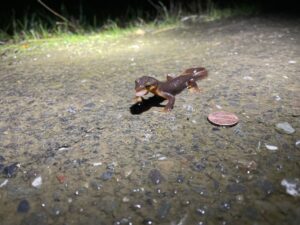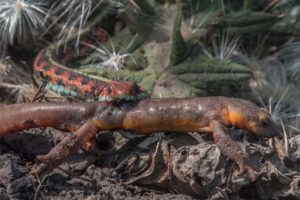
In the 1980s, the BBC produced a nature series about North America called Land of the Eagle. The title is charismatic but it makes little sense biologically: Our two eagle species belong to genera common elsewhere. The series should have been called Land of the Salamander, because North America has more kinds of salamanders — the tailed, mostly four-legged amphibians of the order Caudata — than any other continent, and some of our species are like very ancient ones, suggesting the order might have arisen on some ancestral version of our continent.
I wasn’t aware of our salamander supremacy when growing up in New England, but they were my favorites in the Golden Nature Guide to Reptiles and Amphibians. Finding such secretive but colorful little creatures under logs or in ponds fascinated me. Local red-backed salamanders and red-spotted newts were like old friends, while distant kinds seemed exotic. Out west lived giant, worm, tiger, and tree salamanders, the last of which particularly caught my imagination.

“The Tree Salamander of the Pacific Coast frequently lives in water soaked cavities of trees,” said the guide. “Sometimes a whole colony is found in one of these holes, where eggs are laid, also.” A picture showed elfin creatures climbing around in hilly oak woodland. Another book said they’d been found 60 feet up in red tree vole nests, and that as many as 25 lived in one colony. Another said they had prehensile tails, like opossums. They seemed marvelous.
Childhood fascinations can be disappointing in adulthood, but this one wasn’t. I first arrived on the Pacific Coast one rainy night in December 1968. Driving north through Marin County, I saw little creatures crossing the road. When I pulled over for a closer look, I saw that they were tree salamanders just like those in the Golden Guide, only better: the headlights showed iridescent gold and silver mottling on their skins where the book had shown drab brown.
I was immediately sold on a place where an early fascination could be so quickly fulfilled–or partly fulfilled. In the past decades I’ve seen many tree salamanders, now more commonly called arboreal salamanders (Aneides lugubris). They even inhabit my garden in Berkeley. I’ve never actually seen one in a tree, but that would involve climbing the hollow, rotten ones they frequent on rainy nights. I prefer to take salamanders’ arboreal side on faith. The idea of salamanders in trees still seems marvelous.

Salamander marvels go back a long way. Ancient European legends held that Salamandra salamandra, a species related to newts, could live in fire because of its bright black and yellow markings and because individ-uals sometimes crawled out of logs in fireplaces. Asian lore said that salamanders of mountain lakes could control the weather–a source of dragon legends. California Native American mythology also ascribes magical powers to mountain lake salamanders. Some are thought to protect water purity. Not all Bay Area species inspire such mythic grandeur, but their evolutionary adaptations are pretty amazing.
Arboreal salamanders belong to a family called the Pletho-dontidae, “many-toothed,” because they have so many tiny teeth. They are also called the lungless salamanders because, unlike other kinds, they have lost their lungs in the course of their evolution. (The fish from which amphibians evolved had lungs.) Many of these lungless species live fully terrestrial lives, which seems odd since salamanders that do have lungs must spend part of their lives in water. But plethodontids thrive on land by absorbing oxygen through their moist skins and mouths.
Plethodontids are like most other kinds of salamanders in that they mate by internal fertilization—of a particular sort. Instead of injecting sperm into a female, a male secretes it into a gelatinous packet called a spermatophore that he deposits in front of the female after attracting her by doing little dances (called leibspiel) or rubbing a sexually stimulating gland located on his chin against her snout. If this foreplay is adequate, she picks up the spermatophore with her cloaca and it dissolves inside her and fertilizes her eggs. It isn’t always adequate: I’ve seen breeding places dotted with rejected spermatophores.
Plethodontids do differ from all other kinds of salamanders in the way their young develop after fertilization. Like frog tadpoles, the gilled larvae of most other salamander families need to live in water as they develop into adults after hatching. But plethodontids go through the gilled larval stage inside the egg and hatch as tiny versions of their lungless, gill-less parents. Some plethodontid genera are fully terrestrial: Females lay their eggs underground, often guarding them until they hatch. This uniquely terrestrial group is the most numerous and diverse one in North America, and it has produced the planet’s only tropical salamanders by invading Central and South America and evolving over a hundred species there. Some of these take their arboreal lifestyle to extremes, spending their lives in the rain forest canopy.
Since the group overran America so successfully, it would seem logical that they’d have overrun Eurasia too. But Old World plethodontids are rare. One genus known from Italy and southern France is related to species halfway across the globe here in the Sierra Nevada and Cascades. UC Berkeley Professor David Wake, an authority on salamander evolution, has posited that plethodontids originated in North America and spread into Eurasia during the Cretaceous Period, the late dinosaur age.
The genus in Italy and France was the only known Eurasian plethodontid until 2005, when an Illinois high school teacher turned over a rock in South Korea and found a completely new one–a nearly unprecedented event given the new genus’s isolated location. David Wake, who described the species, calls it “the most exciting and unexpected discovery of my career.” Other new plethodontids keep turning up in America. In 2001, the Scott Bar salamander was discovered at the confluence of the Klamath and Scott rivers.

All Bay Area plethodontid species are fully terrestrial, which is why, unlike water-breeding amphibians, they survive in my garden. Arboreal salamanders aren’t even the most numerous ones there. The California slender salamander, Batrachoseps attenuatus, is almost as ubiquitous as the earthworm. It’s also called the worm salamander because of its elongated body and tiny legs. Both arboreals and slenders prefer to keep out of sight, but I know they’re here when I put out recycling bins in winter. Arboreals sometimes hide underneath, and I often find several slenders coiled there like tiny snakes. Given their numbers in my yard, arboreal and slender salamander numbers in the region must be staggering. A 1956 study of geographic variation in both species on undeveloped islands in the Bay estimated populations of 7,000 slender salamanders and 1,900 arboreals per acre on little Red Rock Island just south of the Richmond Bridge. (Sea level rise after the last ice age probably isolated the salamanders on the islands, although some may have arrived by “waif dispersal” on floating debris.) So they play a big part in the ecosystem, particularly since they are edible. Predators from bears to shrews eat them: I once found an arboreal salamander faced off against a robin on a doorstep in Berkeley. Arboreals can bite hard with their tiny teeth so I don’t know which would have won if I hadn’t scared the robin away. Like lizards, salamanders can escape prey by losing their tails and growing new ones. Unlike all other vertebrates, they can also grow new limbs.
Salamanders, predators in their turn, hunt mainly by sight. They have color vision and can see into the ultraviolet end of the spectrum. Terrestrial species roam at night to grab prey with their toothy jaws or sticky tongues. Anything nonpoisonous is acceptable–spiders, insects, worms, pill bugs, slugs. Large salamanders have been known to eat mice and birds. Aquatic species can also detect prey with a vibration-sensing lateral line organ inherited from fish ancestors. Salamander hearing is probably not good: They lack external ears and have only vestigial inner ears.
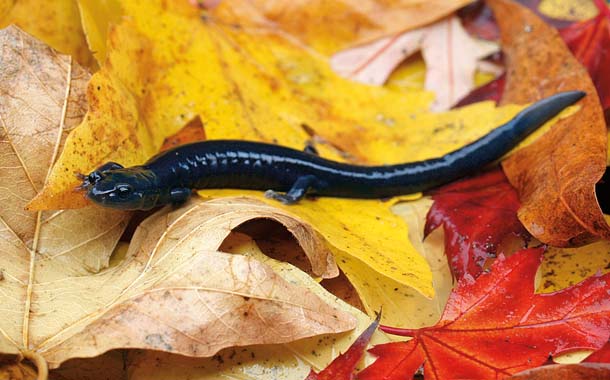
Not all Bay Area plethodontids are easy to find. Another Aneides subspecies, the Santa Cruz black salamander (A. flavipunctatus niger), occurs in the South Bay, but its habitat needs are more specialized: It prefers moist forest environments such as streamsides. Probably because of this specialization, the Santa Cruz subspecies is isolated from another black salamander, A. f. flavipunctatus, that occurs from Sonoma north to Del Norte County.
I have seen some members of the other genus of pletho-dontid that lives here, Ensatina, but never in urban areas. They can be persistent when found. There was a certain log beside the creek in Redwood Regional Park under which, for several years, I could be sure of greeting one Ensatina individual. Nobody knows why Ensatina shuns urbanization–or why slender and arboreal salamanders don’t.
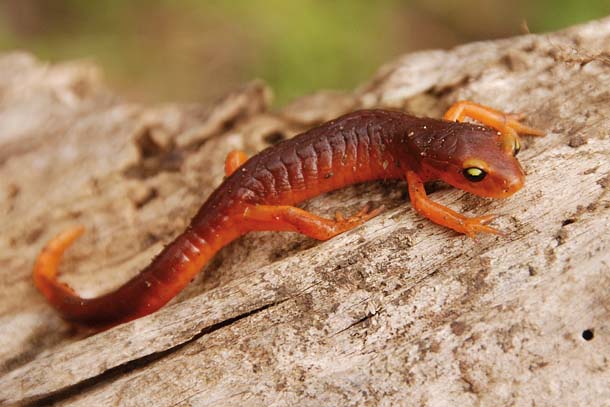
David Wake suspects that despite its distaste for civilization, the local Ensatina subspecies, the yellow-eyed salamander (E. escholtzi xanthopicta), is second only to the slender salamander in numbers locally. A unique trait may help to explain this. Its coloring, brown on top and orange underneath with yellow eye markings, is very like that of the California newt (Taricha torosa), which has highly toxic skin. When disturbed, yellow-eyed salamanders even mimic newt behavior by assuming postures that display their orange undersides. This may be an example of Batesian mimicry, whereby an edible animal evolves through natural selection to resemble a poisonous one.
California newt skin is lethal because it contains an alkaloid called tetrodotoxin that is more toxic than cyanide. The story of a camper who died from accidentally boiling one in the morning coffeepot is an “urban legend” that happens to be true. Mature newts’ only known predator is the common garter snake. Some individual snakes can metabolically neutralize the poison. Newt toxicity varies by location: the Bay Area is a “hotspot,” perhaps because local garter snakes have developed an unusual immunity to the toxins, touching off a biological arms race.
A student of Wake’s, Shawn Kuchta, studied Ensatina mimicry on lands owned by the East Bay Municipal Utility District, putting out several hundred soft plasticine models of the yellow-eyed salamander and of another Ensatina subspecies, the Oregon salamander (E. e. oregonensis), that lives farther north and has a beige belly and black eyes–nothing like a California newt. The experiment showed that although the Oregon salamander’s coloration makes it less conspicuous than the yellow-eyed, predators attacked twice as many of the Oregon models as the yellow-eyed ones. In other experiments, captive scrub jays prudently preferred Oregon salamanders over yellow-eyed ones. Several other Ensatina subspecies overlap with the California newt’s range, but none mimic the newt in the same way.

Batesian mimics tend to be less common or less bold than the toxic organisms they imitate, and yellow-eyed salamanders follow this rule. They largely come out at night, whereas California newts are a frequent daytime sight here in the rainy season. The newt family, the Salamandridae, is the world’s most widely distributed salamander family, occurring in North America, Eurasia, and North Africa. California newts live along the coast from Humboldt to San Diego counties and in the Sierra Nevada. The Bay Area also has another species, the rough-skinned newt (T. granulosa), which occurs from British Columbia south to Santa Cruz County. Poisonous skin probably has a lot to do with newt success because, unlike plethodontids, they need water for breeding, so they must come out in the open to mate.
Bay Area newt adults spend the dry summer months underground in places like ground squirrel burrows, awaiting the winter rains to emerge and move into the water. Males emerge first and develop aquatic features–their skin gets smoother and their tails broaden, becoming more finlike. As females arrive, the males are ready to compete for them and do so vigorously. Ponds teem with “newt balls” as gangs of sex-crazed males engulf females. A winner clasps a female behind her front legs and strokes her snout with his sexual stimulant gland, then swims in front of her and deposits his spermatophore. She lays her fertilized eggs in clusters she attaches to water plants or submerged twigs, and the gilled larvae hatch, grow, and move to land within a few months.
Newt larvae are shyer than adults because their skin poison hasn’t developed. Biologists think adult newts acquire the toxin by ingesting bacteria that produce it. The only place in the Bay Area that I’ve actually seen newt larvae is one shady, sandy-bottomed corner of a vernal pond at Henry Coe State Park. The pale, red-gilled creatures seemed fragile compared to their robust, lascivious parents, but newts remain common, so the larvae must be good at catching aquatic invertebrates and avoiding predators like giant water beetles and dragonfly nymphs.
The Bay Area’s two other salamander families occur only in North America. They depend on water for reproduction and are not poisonous; they survive by staying out of sight. Our most spectacular species, classified in a family by itself, is the California giant salamander (Dicamptodon ensatus), which can grow to 12 inches. Santa Cruz County is the southern extent of its range, since it prefers heavy forest, and adults are a rare sight in daytime. Their sexual privacy policy is the opposite of that of the newts. They mate largely in underground springs, where they also lay their eggs. On the other hand, their gilled larvae can be easy to see in forest streams, since they may grow to adult length before they mature and move underground.
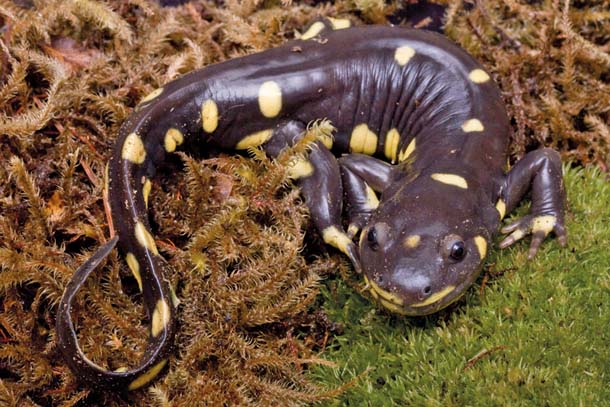
The other Bay Area family is the Ambystomidae, which is our most vulnerable group because of its specialized habitat needs. The tiger salamander, named for its yellow and black blotches, occurs in much of North America, but the California species (Ambystoma californiense) is isolated from the others. It favors grassland, breeding in vernal pools and stream oxbows, which are increasingly rare in the Bay Area. Remaining populations live mainly in nature preserves and wildlife refuges. The Sonoma County population is listed as endangered, and populations in the East Bay and Santa Clara County are considered threatened.
My Golden Guide didn’t mention the rarest of all salamanders here–the long-toed salamander (Ambystoma macrodactylum). Various subspecies occurring from British Columbia to northeast California are fairly common, but the Santa Cruz subspecies (A. m. croceum) breeds only in a few ponds in northern Monterey and southern Santa Cruz counties. It wasn’t discovered until 1954, and Caltrans nearly exterminated it in the 1960s by bulldozing most of its main breeding pond while widening Highway 1. Living beside a major commuter highway, it too is on the endangered list.
Natural climate change probably caused the isolation of the California tiger salamander, Santa Cruz black salamander, and Santa Cruz long-toed salamander. During the last ice age, when weather was cooler and wetter, suitable habitat would have linked Bay Area populations with other ones to the east and north. As weather warmed and dried, habitat loss presumably extirpated populations in between. David Wake thinks changing climates caused the spotty distribution of many other salamander species. He fears that rapid human-caused climate change will combine with habitat destruction, pollution, and other factors to extirpate more salamander populations.
On the other hand, salamanders have been around for hundreds of millions of years, whereas civilization has existed for five thousand. According to some computer models, humans’ resource demand will exceed supply in about a hundred years, a dim prospect for “sustainable growth.” So I wouldn’t count salamanders out. If as prophesied the world ends in fire instead of flood next time, their mythic reputation for creeping out of the flames alive may prove true.
This story has been collected in the book Mountains and Marshes: Exploring the Bay Area’s Natural History, published in 2015 by the Counterpoint Press.

